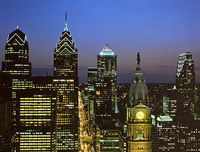Login form
Pennsylvania
 Pennsylvania was founded on the idea of freedom. William Penn of England started the colony in 1682. He wanted a place where people of different faiths could worship freely. The name Pennsylvania means “Penn’s woodland.”
Pennsylvania was founded on the idea of freedom. William Penn of England started the colony in 1682. He wanted a place where people of different faiths could worship freely. The name Pennsylvania means “Penn’s woodland.”
Pennsylvania is a Middle Atlantic state. It reaches from the shores of Lake Erie in the northwest to the salty waters of the Delaware River in the southeast. In these corners of the state the land is low and level. But most of Pennsylvania is covered with rolling hills, mountains, and valleys. Thick forests grow throughout the state.
|
Facts About Pennsylvania |
|
|
|
|
|
Capital |
Harrisburg |
|
Population |
12,400,000 people |
|
Rank among states in population |
6th |
|
Major cities |
Philadelphia, Pittsburgh, Allentown |
|
Area |
46,100 square miles |
|
Rank among states in area |
33rd |
|
Statehood |
December 12, 1787, the 2nd state |
|
State nickname |
The Keystone State |
|
Name for residents |
Pennsylvanians |
|
State bird |
Ruffed Grouse |
|
State flower |
Mountain Laurel |
|
State tree |
Hemlock |
|
Abbreviation |
PA |
THE KEYSTONE STATE
Pennsylvania is one of the 13 original colonies that fought for independence against Britain during the American Revolution (1775-1783). Pennsylvania was located right in the middle, with six colonies to the north and six colonies to the south. On December 12, 1787, Pennsylvania became the second state to join the new United States of America.
Because of its central location, and political importance, people nicknamed Pennsylvania the Keystone State. A keystone is the central stone in a stone arch. It locks the other stones into place. So, Pennsylvania was the keystone holding the 13 states together!
Today, Pennsylvania is the sixth most populated state in the nation. More than 12 million people live there. Harrisburg is the capital. Philadelphia is the largest city, and Pittsburgh is the second largest city.
QUAKERS
William Penn was a member of the Society of Friends, or Quakers. The Quakers were a religious group founded in England. Penn was jailed in England in the late 1600s for his religious beliefs.
Penn founded Pennsylvania so that Quakers and other religious groups might live together in peace. That’s why Pennsylvania is sometimes called the Quaker State.
Quakers believed strongly in individual freedom. They were among the first Americans to condemn slavery. Many antislavery leaders came from Pennsylvania.
CITY OF BROTHERLY LOVE
William Penn named the capital of his new colony Philadelphia, which means “city of brotherly love.” By 1812, the capital had moved to Harrisburg. But Philadelphia remained Pennsylvania’s leading city.
Today, Philadelphia is the fifth largest city in the United States. Its metropolitan area has more than 5 million people. That’s almost half of Pennsylvania’s population!
Philadelphia is often called the Birthplace of the Nation. It played a central role in America’s struggle for independence from Britain.
It was in Philadelphia that the Continental Congresses were held in 1774 and 1775. The Declaration of Independence was adopted in Philadelphia on July 4, 1776. The U.S. Constitution was written in the city in 1787. From 1790 to 1800, Philadelphia served as capital of the United States while Washington, D.C., was being built.
HOME OF BEN FRANKLIN
In 1723, a 17-year-old boy walked into Philadelphia carrying a loaf of bread under his arm. It was Benjamin Franklin, arriving from Boston, Massachusetts! From that point on, Franklin lived and worked in Philadelphia when he wasn’t abroad.
Franklin did a lot in Philadelphia. He published a newspaper. He started the city’s first fire department. He invented the Franklin stove to burn wood more efficiently. He flew his kite and tested lightning for electricity. He invented the lightning rod. He also founded what was probably the first public library in America.
Most importantly, Franklin helped in the founding of the United States. He signed the Declaration of Independence and was involved in creating the U.S. Constitution.
GETTYSBURG
Pennsylvania has seen many important battles in its history. During the American Revolution, large battles were fought at Germantown and Brandywine. But no battle was as big or as important as the one at Gettysburg in July 1863.
The Battle of Gettysburg was a turning point in the American Civil War, a conflict between states of the North and the South. In the battle, the North stopped a major invasion by the South. Afterward, the war turned in favor of the North. Nearly 50,000 soldiers died in the three-day battle.
Four months later, President Abraham Lincoln gave his famous Gettysburg Address when the cemetery at Gettysburg was dedicated. Today, the site is home to the Gettysburg National Military Park.
THE JOHNSTOWN FLOOD
One of the worst floods in American history occurred in southwestern Pennsylvania in 1889. On the night of May 31, the South Fork Dam above the town of Johnstown broke. A huge wall of water swept over the town, killing more than 2,200 people. The American Red Cross, organized in 1881, conducted its first major disaster relief effort in Johnstown.
COAL AND CHOCOLATE
The valleys of Pennsylvania are famous for coal mining. Coal is by far the greatest of Pennsylvania’s mineral resources. For many years, Pennsylvania was a big oil producer, too. In fact, the world’s first commercial oil well was built in Titusville in 1859.
Chocolate is another well-known product of Pennsylvania. In 1905, the famous Hershey chocolate factory opened in Pennsylvania. Today, Pennsylvania is the biggest chocolate-making state in the nation!
Source: Microsoft ® Encarta

